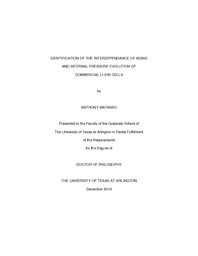
ATTENTION: The works hosted here are being migrated to a new repository that will consolidate resources, improve discoverability, and better show UTA's research impact on the global community. We will update authors as the migration progresses. Please see MavMatrix for more information.
Show simple item record
| dc.contributor.author | Matasso, Anthony | en_US |
| dc.date.accessioned | 2015-07-01T17:50:18Z | |
| dc.date.available | 2015-07-01T17:50:18Z | |
| dc.date.issued | 2014-12 | |
| dc.date.submitted | January 2014 | en_US |
| dc.identifier.other | DISS-12857 | en_US |
| dc.identifier.uri | http://hdl.handle.net/10106/24901 | |
| dc.description.abstract | The demand for high power and energy coupled with long cycle life, low cost, and increased safety have become the driving factors in the development of lithium-ion batteries. This demand continues to expand with the sustained capability expansion of high power military applications, electric vehicles, grid-tie energy storage, and other renewable energy applications. Unlike the short innovation cycles that technologies like portable electronics experience, these applications are focused on an affordable long term product lifecycle that is safe. In order to achieve these long term goals, a better understanding of the chief degradation mechanisms as well as a more sophisticated approach for battery life prediction is needed.This research examined the use of internal pressure evolution of commercial lithium-ion cells as a metric for predicting aging or damage. A novel test chamber was designed and manufactured that enabled commercial cells to be punctured in an inert environment and tested inside of the chamber during full lifecycle, and damage event testing. Three studies were undertaken to examine the internal pressure behavior of li-ion cells: the single cycle internal pressure evolution of a LiFePO₄/C₆ cell over high-rate lifecycle testing, over-discharge characterization of various li-ion chemistries, and a more extensive study aimed at correlating the internal pressure rise and capacity degradation of LiCoO₂/C₆ cells cycled at elevated rates. These studies examined the pressure evolution behavior of the cells and compared this behavior with degradation analysis including electrochemical impedance spectroscopy, capacity fade, DC equivalent series resistance, differential capacity, gas chromatography-mass spectroscopy, and scanning electron microscope imaging. Through the measurement and understanding of the bulk internal pressure behavior, these studies confirmed the ability to detect degradation events like over-discharge, the ability to measure the apparent bulk volume change of the electrodes and correlate this change to the capacity fade of the cell, and the ability to directly correlate the pressure rise with the capacity fade of various cells cycled at high-rate charge and discharge. The addition of internal pressure as an in-situ measurement may be used as a substitute or to supplement other more conventional diagnostic tools. Additionally, this method may be of particular use for systems that are cycled at high rate, high temperatures, or both. | en_US |
| dc.description.sponsorship | Wetz Jr., David A. | en_US |
| dc.language.iso | en | en_US |
| dc.publisher | Electrical Engineering | en_US |
| dc.title | Identification Of The Interdependence Of Aging And Internal Pressure Evolution Of Commercial Li-ion Cells | en_US |
| dc.type | Ph.D. | en_US |
| dc.contributor.committeeChair | Wetz Jr., David A. | en_US |
| dc.degree.department | Electrical Engineering | en_US |
| dc.degree.discipline | Electrical Engineering | en_US |
| dc.degree.grantor | University of Texas at Arlington | en_US |
| dc.degree.level | doctoral | en_US |
| dc.degree.name | Ph.D. | en_US |
Files in this item
- Name:
- Matasso_uta_2502D_12857.pdf
- Size:
- 5.834Mb
- Format:
- PDF
This item appears in the following Collection(s)
Show simple item record


